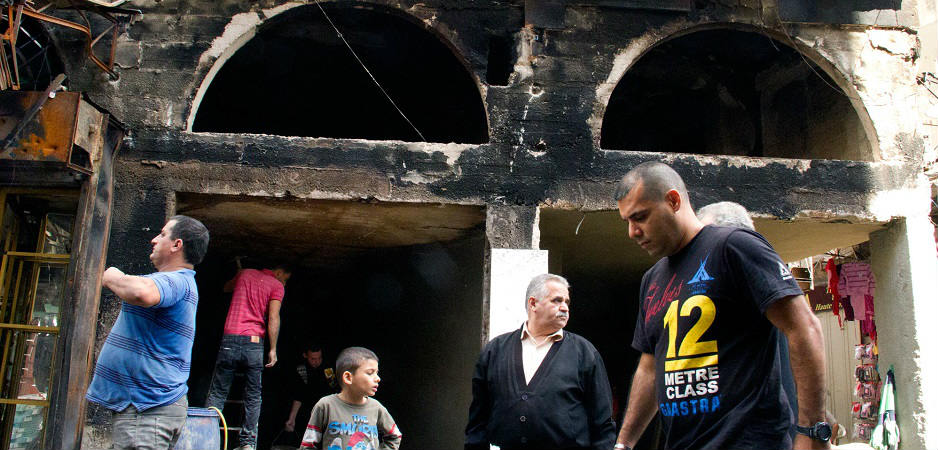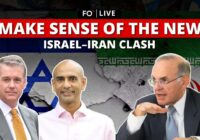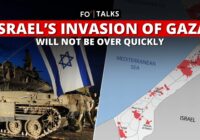The latest clashes in Tripoli in north Lebanon are not just a result of Islamic extremism or a spillover effect from the Syrian war. [Please scroll down for the mini gallery.]
A group of men sat on the sidewalk, drinking Arabic coffee in Tripoli’s old souks. The wall behind them was covered with the shahada (Islamic testimony of faith), which is also written on the flag of the Islamic State (IS). I pointed the camera at them, but before I could push the shutter, one of them angrily got up from his seat and approached me while saying in Arabic: “La, la, la, la sorah!” (No, no, no, no photo!). This was five days after the deadly clashes of late October in Lebanon’s second largest city, or as the Lebanese call it: the capital of the north.
The latest fighting in Tripoli started on October 24 and ended after four days when the Lebanese army retook control of the al-Tabanneh neighborhood. During the clashes, 11 soldiers, eight civilians and 22 militants were killed and more than 100 wounded. Although this was not the first time that the people of Tripoli had fallen asleep to the noise of explosion and gunshots in the background, the latest round of violence was unique in its scale and causes. To fully understand the situation in the city, it is vital to explore the deeper reasons behind the recurring violence in Tripoli.
A New Dimension of Fighting in Tripoli
There has been a long and constant history of armed confrontations in Tripoli. Clashes between the Sunni al-Tabbaneh and the Alawite Jabal Mohsen neighborhoods are not new phenomena. The rivalry between the two communities is deeply rooted in the history of northern Lebanon and goes back to the Ottoman Empire and French colonization – an enmity that reached its climax during Lebanon’s Civil War.
North Lebanon, with its predominantly Sunni population, has been the home of various rebel movements since the end of the civil war in 1990. The Dinnieh (27 kilometers northeast of Tripoli) uprising in north Lebanon in the early 2000s is one example of this. In 2007, the army fought Fatah al-Islam militants in Nahr al-Bared (16 kilometers north of Tripoli) for three months. Though the polarizing events of the Syrian Civil War helped exacerbate the current clashes, these confrontations are also rooted in other important reasons.
During the latest clashes, however, these rival groups from Alawite and Sunni neighborhoods were not fighting each other. An assault from Sunni militants on army forces in the heart of Tripoli sparked the clashes that rapidly spread to the entire city. The attack was triggered by the arrest of Ahmad Salim Mikati, who the army accuses of being affiliated with Islamists in Syria and recruiting young Lebanese to fight against the army.
The four-day fighting in Tripoli was on a larger scale than before. This round of clashes was also not limited to al-Tabbaneh or Jabal Mohsen. The gun battle started in Tripoli’s old souks, a candidate for UNESCO World Heritage status. Other neighborhoods of the old city such as Bab al-Hadid, Zahrieh, al-Tall, al-Dafatir, and al-Moutran also became battlegrounds and for the first time even Mina neighborhood, located near the sea, was affected.
There are two possible endings for the current security turmoil in the city. The first one is that, the army enters the infamous neighborhoods and disarms all militants. If they don’t do that, the second scenario will happen, and conflict will be inevitable.
This was the second time that the Lebanese army was involved in a major battle with Sunni militants in less than three months. The first battle happened in Arsal, a northern town close to the Syrian border, in the first week of August. That clash was between the army and Islamists who have been fighting in Syria. The latest fighting demonstrated that the Lebanese army is not just targeted by militants fighting in Syria, but also by certain groups inside Lebanon that have started to confront the army. The emergence of these groups is a threat to Lebanon, which, 24 years after the end of the civil war, still lives with the fear of another major domestic conflict.
These recent clashes have shown how fragile Lebanon’s current security and stability is. Because of the country’s sharp political divisions, any spark of conflict spreads to different regions and cities. Two weeks before the latest battle in Tripoli, people were waiting for another armed confrontation. After years of living in a conflict zone they could predict what was going to happen. At that time, a woman in Tripoli’s Mina neighborhood, who did not want to be named, told Fair Observer: “There are two possible endings for the current security turmoil in the city. The first one is that, the army enters the infamous neighborhoods and disarms all militants. If they don’t do that, the second scenario will happen, and conflict will be inevitable.”
What Is Behind the Tripoli Clashes?
During the Tripoli clashes the Muslim Scholars Committee was mediating between the army and militants to stop the conflict. When the committee’s spokesperson, Sheikh Adnan Ammama, was asked about the affiliation of the militants, he said: “Some say they are with Nusra [Jabhat al-Nusra], others say they are with ISIS. The affiliations aren’t clear at this point.” A security official also told AFP news agency that most of the fighters were Lebanese and that “some of them are Islamists, while others are wanted thugs.”
Apart from these vague reports regarding the identity of militants, it is difficult to find detailed information about their ambitions. Some people prefer to label them as terrorists without “a functioning head above their skulls” or jihadi groups who “have not learned their lesson” from previous experiences. Others accuse the army of looking for an excuse “to kill north Lebanese.” These simplified assessments of the current situation in Lebanon are misleading. Even reducing the latest fighting in Tripoli to a spillover effect from the Syrian Civil War would be an oversimplification of the complicated situation in Lebanon.
The mainstream media has mainly framed the Tripoli clashes as a consequence of Islamic extremism. However, there are other fundamental causes for the fighting in north Lebanon that have been neglected. Some Sunnis from northern Lebanon accuse the central government of neglecting their political, social and economic necessities and civil rights. Amongst other Sunni figures, Sheikh Khaled Hoblos pointed at these inequalities as the main reason for the clashes in the Tripoli area. Social privilege, economic opportunities and Lebanon’s cultural offerings are largely concentrated in the capital Beirut. As a result, many middle-class young people from Tripoli have moved to the capital in search for more social and economic opportunities.
The economic situation of northern Lebanon is another reason for the unending clashes in this region. According to a United Nations Development Program (UNDP) field survey from 2011, 67% of the population in Jabal Mohsen and Bab al-Tabbaneh in Tripoli lives below the upper poverty line, with 33% below the lower poverty line. In these two neighborhoods, 50.4% of families have a monthly income of less than $333 and 82% under $533, significantly below the national average. The same data shows that Tripoli’s share of bank loans to the private sector in Lebanon does not exceed 2%, compared to 83% in Beirut and its suburbs.
They recalled the recent clash as if it were nothing out of the ordinary: They spoke as if these were increasingly a routine part of life. When asked whether they thought the clashes would end soon, they just gave a hopeless smirk.
After the recent clashes in Tripoli national media outlets such as LBCI highlighted the city’s economic situation. In early November, two videos on LBCI went viral on social media: Both showed people in Tripoli criticizing their economic situation. A young man from Tripoli, who did not want to be named and now lives and works in Beirut, believed that the main reason for the clashes in Tripoli is economics. He told Fair Observer: “It is all about the fight between the bourgeois and poor. Tripoli’s rich people can save the entire city, but they prefer to invest their money outside the country.” It is important to acknowledge that the long-term violence in northern Lebanon is rooted in and fueled by decades of economic and social neglect and inequality.
Hopeless Smirk
Five days after the end of the Tripoli clashes, shop owners in the old souks were still cleaning up the mess from the fighting. Many shops in the city’s historic quarter were burned down during the fighting. During this author’s visit, merchants were removing broken glass and repainting the walls that were blackened by explosions and fire. They recalled the recent clash as if it were nothing out of the ordinary: They spoke as if these were increasingly a routine part of life. When asked whether they thought the clashes would end soon, they just gave a hopeless smirk.
There are many Lebanese who have the same answer when asked about the future of their country. But at the same time, they are afraid of the coming days. They are worried that the security situation could get even worse. This anxiety is not tied to a specific region in the country and is noticeable everywhere. Even Beirut on some days changes its seductive face and looks more like a barrack.
It is not just the sectarian divisions that have fueled the recent clashes and instability in Lebanon. It is very difficult to find political consensus to resolve the country’s domestic problems. In the presence of political strife, what has been forgotten are people’s daily economic, social and cultural issues. Subsequently, Lebanon is likely to remain volatile. This vulnerability can be easily exacerbated by the regional crisis such as the Syrian Civil War or domestic rivalries between Shia and Sunni groups. Although the impact of these crises on the country’s situation is undeniable, they are not the fundamental causes of Lebanon’s instability.
The current situation will not improve unless Lebanon’s politicians find a way to reach a consensus on the country’s most pressing issues. In the absence of an agreement to find solutions for fundamental issues such as security, socioeconomic backwardness and sectarianism, Lebanon will continue to face future challenges.
The views expressed in this article are the author’s own and do not necessarily reflect Fair Observer’s editorial policy.
© Changiz M. Varzi
Support Fair Observer
We rely on your support for our independence, diversity and quality.
For more than 10 years, Fair Observer has been free, fair and independent. No billionaire owns us, no advertisers control us. We are a reader-supported nonprofit. Unlike many other publications, we keep our content free for readers regardless of where they live or whether they can afford to pay. We have no paywalls and no ads.
In the post-truth era of fake news, echo chambers and filter bubbles, we publish a plurality of perspectives from around the world. Anyone can publish with us, but everyone goes through a rigorous editorial process. So, you get fact-checked, well-reasoned content instead of noise.
We publish 2,500+ voices from 90+ countries. We also conduct education and training programs
on subjects ranging from digital media and journalism to writing and critical thinking. This
doesn’t come cheap. Servers, editors, trainers and web developers cost
money.
Please consider supporting us on a regular basis as a recurring donor or a
sustaining member.
Will you support FO’s journalism?
We rely on your support for our independence, diversity and quality.







Comment